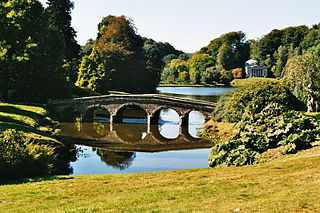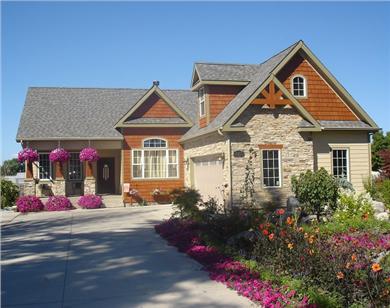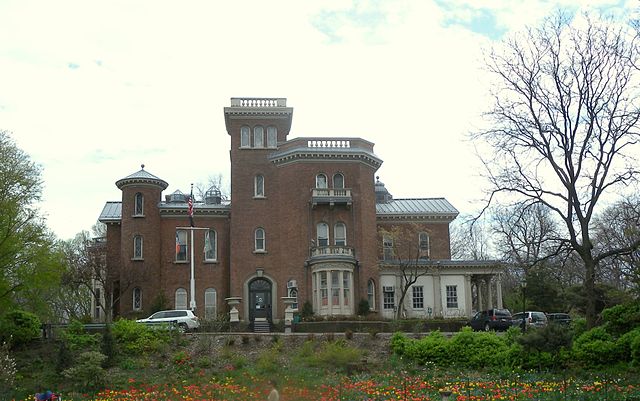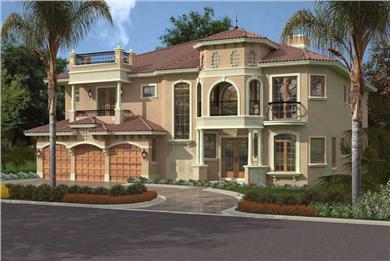Landscape Architecture: Influences and Trends in Whole House Design

Looking Beyond the House Plan Blueprint: Trends and Tips for Homeowners Thinking About Landscaping and Gardening Their Home
So you’ve found your perfect house plan – or just about to start building your home? Today’s approach to whole house design also includes thinking about how to landscape your home. From the picturesque English landscape gardens to Monticello, to the luxuriant expanse of Central Park, and even to the tiniest blooms in urban roofs, gardens and landscapes celebrate man’s ability to create patches of tranquility and extol the beauty of nature. People have always loved flowers, plants and trees – from poets who were inspired to write about gardens, to modern day homeowners who enhance their properties with manicured lawns, seasonal blooms and vegetation.
While landscaping and gardening options can vary widely depending upon budget, a home owner on even a limited budget can often create extraordinary outdoor surroundings with some creative thinking. Looking at the gardening and landscaping pioneers of the past is often a good way to start getting ideas and inspiration for the present.

A modern landscape design illustrated in this Texas living style house plan.
The Beginnings of Landscape Architecture
Gardens and landscape planning have been in vogue for centuries, and in the early 18th century, landscape planning consisted mostly of elaborate garden designs for manor houses, palaces and royal properties. During those times, gardens and parks within the palatial grounds were showpieces, meant to impress visitors - with their vast lawns, woods, hedges, fountains and statues. The English garden with its recreation of an ideal pastoral landscape became the principal gardening style of Europe. It usually included a lake, rolling hills, groves of trees, temples, Gothic ruins, bridges and other picturesque architecture.


Blenheim Palace Park (Oxfordshire, England) was designed by Lancelot “Capability” Brown who is considered the most influential figure during the great age of the English garden. To the right, one of the first “picturesque” gardens was Stourhead. Located in Wiltshire, it was created by Henry Hoare, a wealthy banker.
(Left image credit: F.O. Morris c1880; right image credit: Stourhead Garden by Lechona / CC BY-SA 3.0)
As grand and stately as these English gardens were, the working class English reacted to their formal structure and designs. So the English cottage garden emerged - with its informal look, mixture of flowers, herbs, vegetables, fruit trees, and ornamental and edible plants. Instead of the sprawling lawns and hills, the cottage garden was enclosed, typically with a rose-bowered gateway.


William Shakespeare’s wife Anne Hathaway’s “Cottage Garden” and Tudor style cottage in Warwickshire, England. She lived in the 12-room farmhouse about a mile from Stratford-upon Avon. To the right, The Fountain Terrace at Dumbarton Oaks – designed by Beatrix Farrand.
(left photo credit: Hathaway Cottage by Bjenks / CC BY-SA 3.0; right photo credit: The Fountain Terrace by Passionvine / CC BY-SA 3.0)
Roses were a tradition. In addition, there were primroses, violets, daisies, climbing plants, and flowering herbs. Each flower had practical uses: violets for their scent and ability to keep out insects; calendulas and primroses for cooking.

The “Cottage” American style – a country style house plan from The Plan Collection with a garden in front and colorful blooms adorning the entranceway.
Landscape Architecture in the 19th Century
With the dawn of the Industrial Age and urban growth, people started moving out of rural areas to cities/urban centers. The resulting crowding and limited space brought challenges, and with it the realization that cities had to be “more functional, welcoming and aesthetically pleasing to their inhabitants.”
Frederick Law Olmsted (1822-1903), the renowned designer of Central Park, was the first professional to describe himself as a “landscape architect.” This title was formally established when Olmsted, Beatrix Farrand, and several colleagues founded the American Society of Landscape Architects in 1899. Farrand was the only woman among the founding architects of ASLA. She served as design advisor for leading universities including Yale, Princeton and Harvard. Farrand is most famous for the gardens at Dumbarton Oaks in Washington, D.C.

Dumbarton Oaks in the Georgetown section of Washington, D.C.
(Photo credit: Jack Boucher, National Park Service, US Dept of the Interior)
As for Olmsted, the “Father of Landscape Architects,” he completed a series of parks that continue to have a huge impact on the practices of landscape architecture in the modern world. In addition to Central Park, he also designed Prospect Park in Brooklyn, N.Y. and Boston’s Emerald Necklace park system.

The boathouse near Lullwater Bridge in Prospect Park provides a romanitc place for visitors to get closer to the water.
(Photo credit: Tyler Goodell on Unsplash)


Litchfield Villa (a NYC Landmark) in Prospect Park was the residence of railroad magnate and real estate developer Edwin Litchfield and his family To the right: How’s this for a modern day take on a Mediterranean style villa and attractive, warm-weather landscaping?
(Left photo credit: Litchfield Villa PPW by jim.henderson / CC BY-SA 3.0)
Landscape Architecture Today
Today, landscape architects play an important role in urban and rural development all over the world. They design suburban gardens, public parks, monuments, streetscapes, mediation gardens, college campuses, and various other landscapes. They are involved with hospitality and resorts, historic preservation and restoration, conservation, waterway restoration and reuse, landscape art and earth sculpture, interior landscapes and more.
In every design, they live by the concept of whole house design or whole building design – that a “well-designed property, when developed within ‘whole building’ design principles, is properly integrated with its surroundings; is a good neighbor within the community where it rests to other structures and its natural setting: and should be accessible, secure, and aesthetically pleasing from the outside.”
Selecting a house plan or architectural style that appeals to you while also fitting in with your geography, landscape environment and immediate surroundings is a good start to whole building or whole house design.
Plan Results
OR ENTER A PLAN #
Blog Resources

Home Design & Floor Plans

Home Building

Architectural Styles/Architecture






